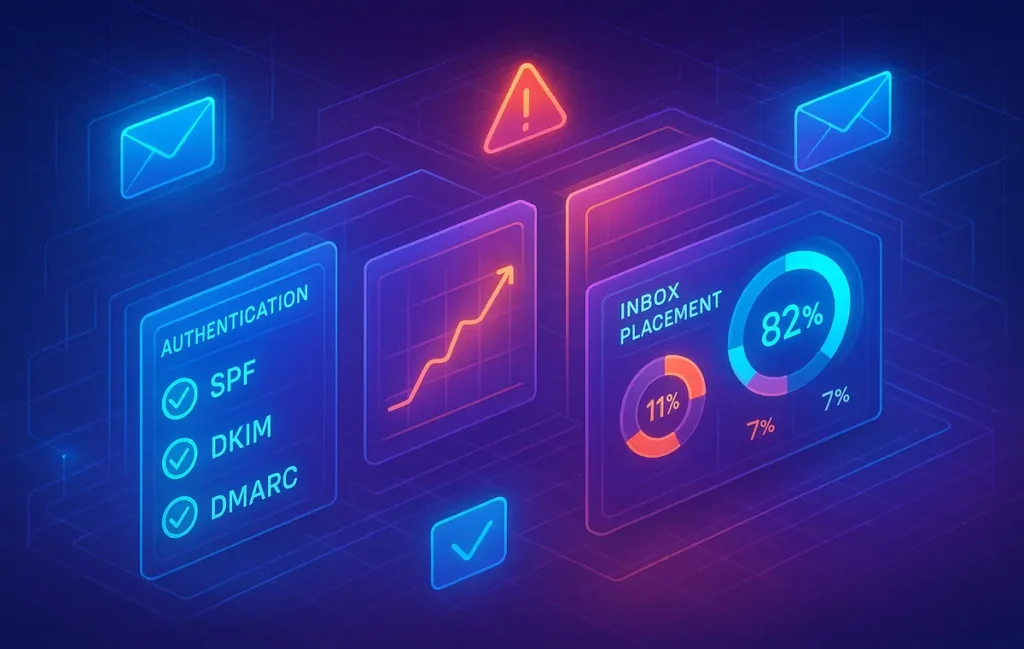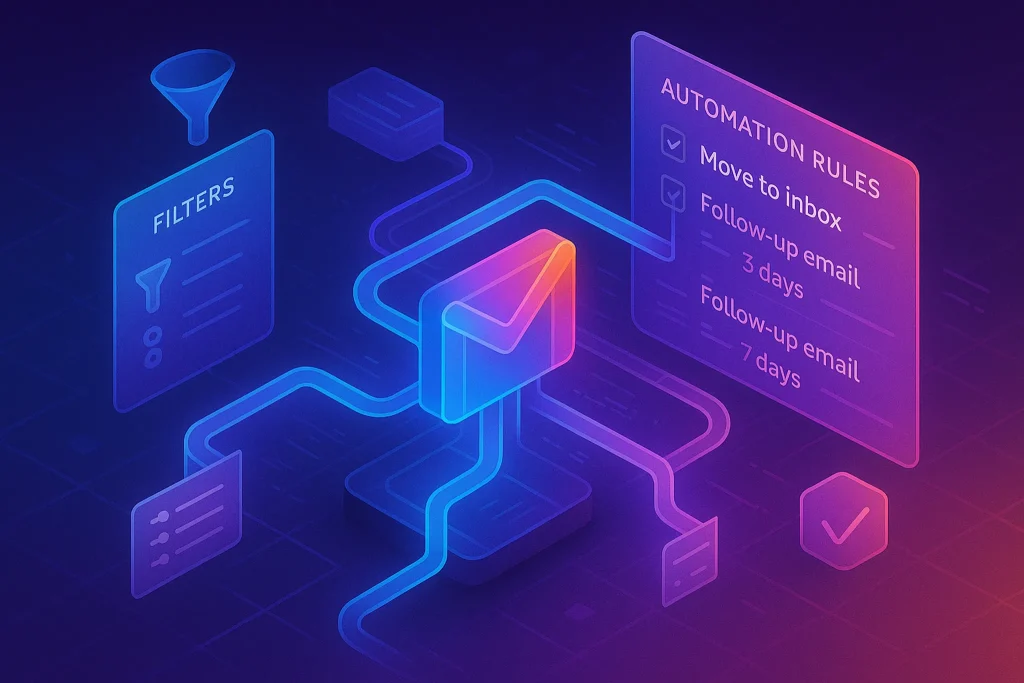📬 Introduction: Why Deliverability Matters More Than Ever
It doesn’t matter how clever your subject line is or how strong your offer sounds—if your emails don’t reach the inbox, your campaign fails before it starts. Many marketers confuse delivery with deliverability. Just because an email was “sent” doesn’t mean it landed where it needed to. It may have slipped into spam folders, been filtered out by ISPs, or blocked entirely.
As more businesses adopt AI-powered campaigns and automation, inboxes are more crowded than ever. Email providers like Gmail and Outlook aggressively filter incoming messages. In this environment, improving deliverability is the single most impactful step you can take to protect your marketing ROI. NerdChips has seen brands achieve 25% higher campaign returns simply by fixing deliverability issues before launching new automations.
💡 Nerd Tip: Think of deliverability as reputation management for your domain. If inboxes trust you, your audience sees you. If not, your words vanish into the spam abyss.
📖 What is Email Deliverability?
Email deliverability refers to the ability of your emails to actually land in recipients’ inboxes—not just to be sent successfully. Delivery rate measures how many emails left your sending platform. Deliverability rate measures how many bypassed spam filters and appeared in the inbox.
For example, a 99% delivery rate sounds fantastic. But if 40% of those emails are flagged as spam, your deliverability rate is only 59%. That’s the number that really matters for campaign performance.
Unlike delivery, deliverability depends heavily on domain reputation, content quality, engagement signals, and technical authentication settings. Without attention to these elements, even the best-written campaign can underperform.
🔐 Authentication Basics
Email authentication is your first line of defense against being flagged as spam. Internet service providers (ISPs) rely on authentication protocols to determine whether your email is legitimate or forged.
SPF (Sender Policy Framework): SPF verifies that emails are sent from servers authorized by your domain. Without SPF, spammers can impersonate you.
DKIM (DomainKeys Identified Mail): DKIM attaches a digital signature to your messages, proving the content wasn’t altered during transit.
DMARC (Domain-based Message Authentication, Reporting & Conformance): DMARC combines SPF and DKIM to give ISPs clear instructions on how to handle unauthenticated messages. It also sends reports back to you.
BIMI (Brand Indicators for Message Identification): BIMI adds a visual layer by displaying your brand logo in inboxes that support it, reinforcing trust and visibility.
Testing is crucial. Tools like MXToolbox or Google Postmaster can validate whether your SPF, DKIM, and DMARC records are set up correctly. Missing one record is often the invisible reason behind poor inbox placement.
💡 Nerd Tip: Don’t just “set and forget.” Recheck authentication records after DNS changes or platform migrations—they can silently break.
🌡️ Warming Up Your Email
Even with perfect authentication, blasting thousands of emails from a new domain will raise red flags. ISPs monitor sending patterns, and sudden spikes scream “spammer.” This is where warming comes in.
Email warming is the gradual process of increasing your sending volume so inbox providers build trust with your domain. You start by sending small batches—say, 20 emails per day—and gradually scale up over weeks. The goal is to demonstrate consistent, healthy engagement before you push at full scale.
Automation tools like Warmup Inbox and Instantly make this process smoother. They send controlled volumes, simulate engagement (opens, replies), and help establish a positive sender reputation without manual effort.
💡 Nerd Tip: Treat warming as an investment. A few weeks of discipline can safeguard years of campaign ROI.
📊 Monitoring Deliverability
Deliverability isn’t “set once and done.” It needs ongoing monitoring, just like SEO rankings or ad performance.
Key metrics to watch include:
-
Open Rates: Declining open rates may signal inboxing issues, not just poor subject lines.
-
Bounce Rate: High bounces damage reputation and signal list hygiene problems.
-
Spam Complaints: Even small complaint spikes can tank your domain reputation.
Specialized tools give visibility beyond your ESP dashboard. GlockApps, for instance, runs inbox placement tests across multiple providers. Postmark offers real-time bounce insights. Mailgun gives granular deliverability analytics, useful for developers and teams scaling advanced automations.
💡 Nerd Tip: If your open rate drops by 10% or more without a major content change, investigate deliverability before assuming your audience lost interest.
🚫 Common Mistakes to Avoid
Many businesses sabotage deliverability through avoidable mistakes:
Buying Email Lists: This might expand your reach quickly but guarantees poor engagement and high spam complaints. Quality lists are built, not bought. See our Ultimate Guide to Building an Email List with AI Tools for safer alternatives.
Over-Sending: High frequency without engagement signals tells ISPs you’re a nuisance. Moderation preserves trust.
Skipping Authentication: Neglecting SPF, DKIM, or DMARC is like mailing a letter without a return address. Even if it gets delivered, no one trusts it.
💡 Nerd Tip: Deliverability is fragile. Fixing mistakes takes much longer than preventing them in the first place.
📂 Case Study: From Spam Folder to ROI
A SaaS startup in Europe struggled with 50% of its marketing emails landing in spam. Their campaigns looked polished, but inboxes didn’t trust them.
The team implemented SPF, DKIM, and DMARC correctly, then warmed up a new sending domain over six weeks using Instantly. They also pruned inactive contacts from their list. Within two months, inbox placement rose from 50% to 92%, and open rates doubled.
As one of their marketers shared on X:
“We didn’t change a single word in our campaigns. Deliverability alone turned a failing channel into our #1 ROI driver.”
This case illustrates how technical tweaks often yield more results than new copywriting.
⚡ Ready to Improve Your Inbox Placement?
Tools like Postmark, Mailgun, and GlockApps can help monitor deliverability, authenticate domains, and safeguard ROI. Don’t guess—test and verify.
📊 Engagement Signals & Behavioral Metrics
Inbox providers don’t just look at technical authentication—they study how your recipients behave. Every open, click, reply, or forward acts as a positive signal, while spam complaints or mass deletions act as negative ones. Over time, these behaviors create a sender “score” that influences inbox placement.
Boosting engagement is about sending the right content to the right people at the right time. Segmentation plays a big role: a segmented list where each subscriber receives relevant content generates higher opens and clicks, which signal to Gmail or Outlook that your messages are valued. Interactive elements—like asking subscribers to reply with feedback or vote in a poll—also help because replies are treated as proof of genuine conversation.
On the flip side, sending broad, irrelevant campaigns to disengaged audiences lowers engagement. Even a technically perfect email with SPF, DKIM, and DMARC can still be filtered if users ignore it. Deliverability and engagement go hand in hand.
💡 Nerd Tip: Engagement fixes reputation faster than volume reduction. If inboxing drops, focus on segmenting and re-engaging your most active users first.
⚖️ Legal & Compliance Angle (GDPR / CAN-SPAM)
Compliance with email regulations isn’t just about avoiding fines—it directly supports deliverability. Laws like GDPR in Europe and CAN-SPAM in the U.S. require explicit opt-in, clear unsubscribe links, and transparent sender information.
When recipients knowingly subscribe, they’re less likely to mark emails as spam. That lowers complaint rates and improves your domain’s reputation. Unsubscribes may feel like lost opportunities, but they protect engagement rates by removing disinterested users before they generate negative signals.
A hidden benefit of compliance is psychological: when users trust that your brand respects their privacy, they’re more willing to engage. Platforms like NerdChips have seen higher engagement on double opt-in lists than single opt-in lists, even if the latter grows faster.
💡 Nerd Tip: A smaller, fully compliant list outperforms a massive unverified one. List quality, not size, drives deliverability.
🔄 Domain & IP Rotation
For high-volume senders—think SaaS platforms or e-commerce stores pushing millions of emails per month—domain and IP strategy becomes essential.
Using multiple subdomains (e.g., promo.brand.com, news.brand.com) allows you to segment traffic by purpose. This protects your main domain’s reputation if one stream faces issues. Dedicated IPs, meanwhile, give you full control over sender reputation instead of sharing it with other businesses on a pooled service.
However, domain and IP rotation isn’t a shortcut for poor practices. If your content causes complaints, even multiple IPs will suffer. The strategy only works when combined with authentication, warming, and engagement best practices.
💡 Nerd Tip: Reserve your main domain for transactional or mission-critical emails. Run experiments on subdomains so your brand reputation stays protected.
🤖 AI & Predictive Deliverability
AI has entered the deliverability space in exciting ways. Predictive deliverability tools analyze your email before you hit send, flagging potential spam triggers in subject lines, body copy, or formatting. Some tools even benchmark your draft against millions of historical campaigns to forecast inbox placement probability.
AI also powers send-time optimization. By learning when each subscriber typically opens emails, platforms can stagger sends so every recipient gets the message at their personal peak time. This boosts open rates, which in turn improve reputation and deliverability.
In practice, marketers report up to a 15% lift in open rates when layering AI predictions on top of authentication and warming strategies. Paired with personalization (see How to Use AI to Personalize Email Campaigns), AI ensures your campaigns are not just delivered but welcomed.
💡 Nerd Tip: Test AI subject-line generators cautiously. Predictive AI may say a line is effective, but A/B testing with real audiences is the only true judge.
🛠️ Troubleshooting Deliverability Drops
Even with the best setup, deliverability can fluctuate. Knowing how to troubleshoot quickly separates resilient marketers from frustrated ones.
First, check blacklists like Spamhaus to ensure your IP or domain hasn’t been flagged. If listed, you’ll need to fix the underlying issue (complaints, poor list hygiene) and request delisting.
Next, monitor bounce codes. Hard bounces often signal bad addresses, while soft bounces may indicate temporary ISP issues or throttling. A sudden spike usually means your list quality needs attention.
Seed testing is another powerful tactic. By sending test emails to seed addresses across different providers, you can see exactly where messages land: inbox, promotions tab, or spam. Tools like GlockApps automate this at scale.
💡 Nerd Tip: When in doubt, send a small batch to your most engaged users. If they land in inboxes, the issue is likely list or volume-related—not your technical setup.
📐 Pre-Send Checklist
Before every campaign, run through this deliverability checklist:
| Step | Why It Matters | Quick Action |
|---|---|---|
| SPF/DKIM/DMARC | Core authentication | Validate with MXToolbox |
| Domain Warmth | Trust with ISPs | Scale volume gradually |
| Engagement | Positive signals | Segment active users |
| Blacklist Check | Prevent blockages | Run Spamhaus check |
| Frequency Control | Avoid fatigue | Space campaigns wisely |
💡 Nerd Tip: Treat this as your “pre-flight” checklist. Skipping even one step risks your entire campaign.
📬 Want More Smart Email Tips Like This?
Join our free newsletter and get weekly insights on email tools, automation hacks, and AI personalization—delivered straight to your inbox. No fluff. Just high-quality content from NerdChips.
🔐 100% privacy. No noise. Just actionable tips for better deliverability and ROI.
🧠 Nerd Verdict
Email deliverability isn’t glamorous, but it is mission-critical. Authentication protects your domain’s reputation. Warming builds trust with ISPs. Monitoring ensures you catch issues before they sink campaigns. When combined, these three steps create a foundation stronger than any flashy design or AI-powered subject line.
For marketers and founders, deliverability is not optional. It’s the difference between shouting into the void and building profitable, lasting conversations with your audience.
❓ FAQ: Nerds Ask, We Answer
💬 Would You Bite?
If fixing deliverability could increase your email ROI by 25%, would you prioritize it over launching brand-new campaigns?
Crafted by NerdChips for marketers who know that inbox visibility is the foundation of profitable campaigns.



